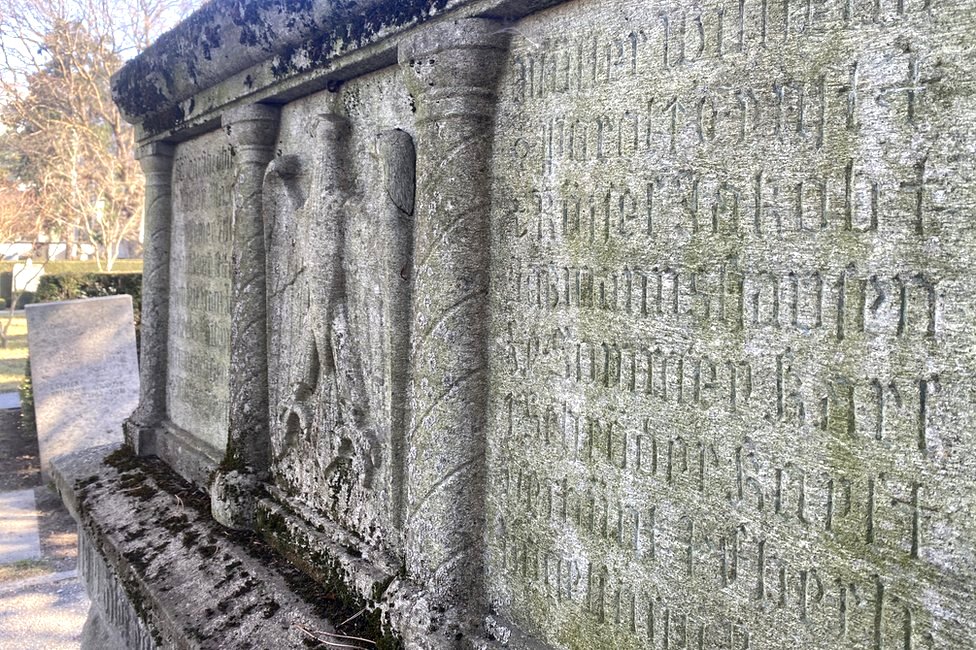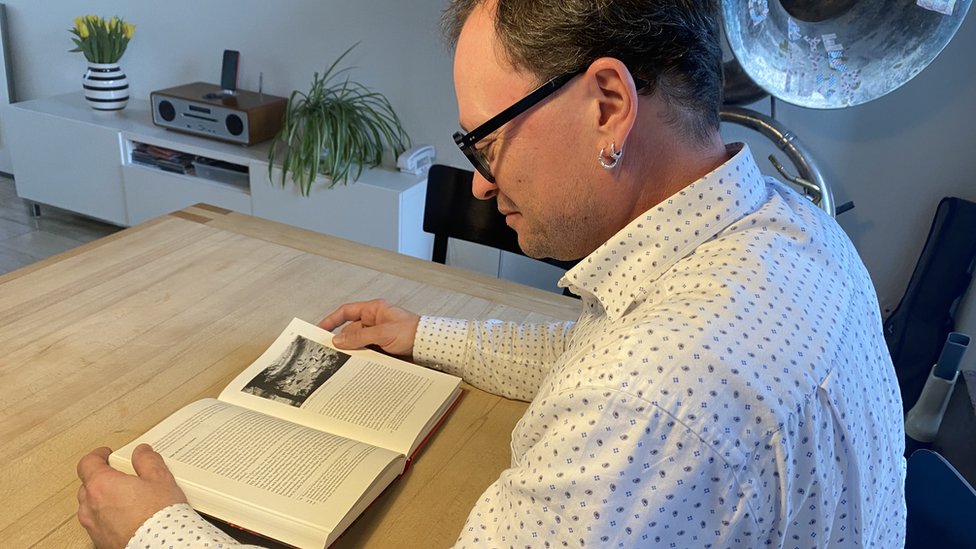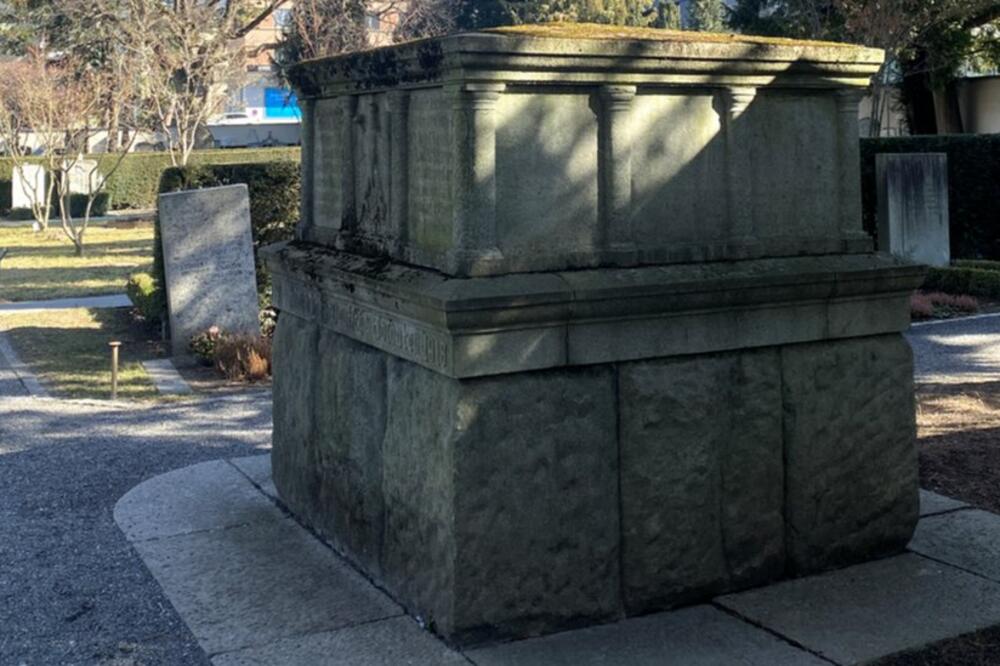For decades, people walked past a huge monolithic granite block in the middle of a cemetery in the Swiss town of Hür without paying any attention to it.
No one seemed to know what it represented.
But the 13-tonne stone monument towering over nearby gravestones is now causing controversy - and embarrassment.
Research by a local journalist revealed the monument's connections with Nazi Germany and with neutral Switzerland's unpleasant relations with its neighbors from World War II.
- A Nazi treasure hunt in a village in the Netherlands has angered the locals
- Nazi camp Dachau: How one of the survivors helped to convict the "sadists"
- Women who tried Hitler's food
The cemetery is in the city center.
Many people, like radio journalist Stefani Hablucel, pass by there every day on their way to work or shopping.
Today, the monument in the cemetery is untidy, covered with moss.
The prints on it are hard to make out.

"At first glance it looks like a war memorial," Stefani says, spelling out the barely visible inscription: "1914 - 1918; hier ruhen deutsche Soldaten... German soldiers lie here."
Why, however, would German soldiers be buried here?
In fact, thousands of wounded prisoners of war, French and British as well as German, were treated and interned in Switzerland during the First World War.
Some died from their wounds, others during the 1918 flu pandemic.
But the monument in this place was erected only in 1938.
"It's 20 years after those people died," Stefani says.
"It was not erected in honor of those soldiers, but for propaganda reasons, for the Nazi regime".
Swiss historian Martin Bucher explains that as the Nazis consolidated power in Germany, their propaganda included a cult-like worship of their war dead.
The German War Graves Commission became part of Hitler's propaganda machine in the 1930s.
Her task was to create visible signs of Nazi power both at home and among Germany's neighbors.
There were thousands of Germans living in Switzerland at the time and, says Martin, they were organized.
"In Switzerland there were all these organizations that you know from Germany. National Socialist Party, German Workers' Front, Hitler Youth. Everyone was here, but only for the Germans, not for the Swiss."
The German War Graves Commission has submitted ambitious plans to build a huge mausoleum in the Swiss city of St Gallen.
This was rejected by the Swiss authorities.
But the monument in Hur was approved.
Polished and engraved in Munich, using a font favored by the Nazis fractur, was delivered to the Swiss city on the eve of World War II.
At the time, Martin says, Hur residents had to know what it was.
"During the Nazi holidays, they put swastikas on the monument...people had to see what it was about and know that this was a Nazi monument."
Some, however, were aware of what it was about and were not satisfied.
Stefani revealed a sharply intoned letter to a local newspaper, written in 1938, asking: "Why do we have a Nazi stone in our cemetery?".
There were also those who supported.
Swiss sympathizers of Nazi Germany were well known in the canton of Graubünden, of which Hur is the capital.
But the domestic Swiss Nazi parties never really took off, winning only two seats in the Swiss parliament in 1935 and never again being elected.
Although Switzerland does not yet have an official Holocaust memorial, the parliament approved plans for such a memorial in March last year.
There are, however, about 50 unofficial monuments.
Throughout the war, Germans in Switzerland continued to be active in the Nazi party and continued to express Nazi sympathies.
And the Swiss, hoping as usual to stay out of the fighting, made compromises with Berlin, kept Nazi gold in banks and refused Jewish refugees.
Then, only a day after the end of the war, neutral Switzerland tried to "wash" itself.
"There was a huge purge," says Martin.
"The Swiss government tried to punish the Swiss Nazis, there were trials".
Meanwhile, the German Nazis were expelled.
"I think after that a lot of people thought it was over now, the Nazis were gone, no problem," says Martin.
"And I think they forgot this monument".

This collective amnesia was so complete that today, among people like Stephanie, born decades after the war, the origins of the monument and the Nazi presence in Switzerland are a revelation.
"I grew up here in Hura," she says.
"And I didn't realize how many Nazi organizations were present here in the 1930s."
Even local councilor Jon Pult is surprised.
"Switzerland was not free from the Nazis, and I know that," he says.
"But I didn't know about this monument.
"I live maybe 500 meters from the cemetery where this stone is, and I've passed by it probably a hundred times, and I never realized it was a Nazi marker.
"Now I understand and see it very clearly".
- Monument to innocent victims in Novi Sad: "Relativization of crime" or "civilizational achievement"
- The letter that revealed the secret life of Josef Mengele
- "Lots of violence, profanity and nudity": School in America bans children from learning about the Holocaust through the comic book Maus
What could happen now?
Despite a certain sense of shame, very few people proposed to demolish the monument.
But even less, Stefani adds, says it should be left as it is.
Instead, a consensus appears to be on the horizon for a proposal to review and publicize that period in Swiss history, just as Switzerland had to review and apologize for its treatment of Jewish refugees during the war.
"I think it should stay in Hur," Martin says, adding: "But I think it's important to tell people why it's there."
"Perhaps it could be turned into a memorial to all the people who died in the Second World War."
Jon Pult agrees that Switzerland should "make him a monument that would remind us of the terrible crimes of the Nazis".
But, he adds, it should also serve as a warning, and he expects that along with it, information will be posted on the cemetery about what it is really about.
"We should create a culture of knowledge about this, because as we know, there is always a danger of fascist ideologies, totalitarian ideologies, such as we see now, for example, in Russia," says the local councilor.
Follow us on Facebook,Twitter i Viber. If you have a topic proposal for us, contact us at bbcnasrpskom@bbc.co.uk
Bonus video:




